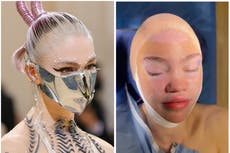Brazilian Butt Lifts get guideline makeover to make them safer
The wildly popular procedure results in one death in every 3,000 people who undergo it
Plastic surgeons in the UK have released an updated set of guidelines that aim to make Brazilian Butt Lift (BBL) procedures safer.
The procedure involves removing fat from elsewhere in the body and injecting it into the butt cheeks to make them bigger.
In recent years, BBL surgeries have soared in popularity despite it being notoriously dangerous, resulting in one death in every 3,000 people who have undergone the procedure.
The British Association of Aesthetic Plastic Surgeons (BAAPS) told its members not to perform the lifts after two British women died following the procedure in 2018.
Now, the organisation has revised its guidelines on BBLs to recommend that the injections should not go as deep as the muscle layer to prevent dangerous complications such as clots.
Surgeons performing the procedure should inject fat “into the subcutaneous plane only”, as evidence “shows that the only deaths from the procedure have been when fat has been injected into the deeper muscle layer”.
In addition, the organisation is mandating the use of intraoperative ultrasound when the fat is injected into the butt area to ensure it remains in the layer of tissue just under the skin.
“This is the only way surgeons can be confident they are not in the muscle layer,” BAAPS said.
BAAPS is steering plastic surgeons away from the term “BBL” and has called the safer procedure Superficial Gluteal Lipofilling (SGL).
The group’s president Marc Pacifico said: “The new BAAPS guidelines are very robust and comprehensive and the evidence has been critically analysed.
“The deaths recorded with BBL have all had breeches of the fascia with fat injected into the muscle. So, it’s no the BBL but yes to Superficial Gluteal Lipofilling where the fascia is not compromised.”
He added: “To ensure this, we are recommending that surgeons should only perform this with real time ultrasound guidance as the only way to ensure the procedure is performed superficially and safely.”
In 2020 alone, 40,320 butt augmentation procedures were recorded by The Aesthetic Society, including fat grafting through BBLs and buttock implants.
But BBLs outstrip buttock implants in popularity to become the most popular means of creating a bigger butt.
UK surgeons expressed concern over the number of people going overseas to get the procedure and warned that these patients are at risk of exposure to complications like “sepsis, poor techniques, deep vein thrombosis, and pulmonary embolism”.
Pacifico added: “The majority of BBL complications seen in the NHS are related to sepsis, fat necrosis and skin necrosis. So, by introducing the new guidelines, we will help protect the public seeking this procedure.”
Join our commenting forum
Join thought-provoking conversations, follow other Independent readers and see their replies
Comments




Bookmark popover
Removed from bookmarks